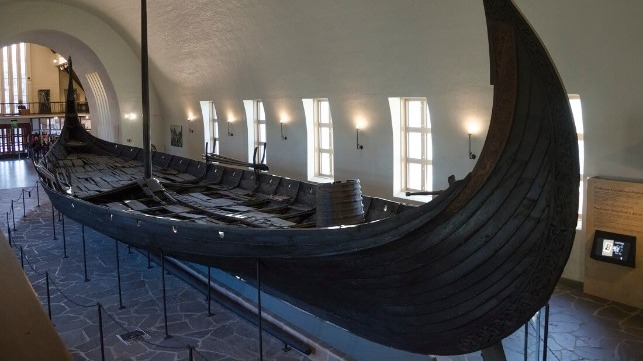(By Bjørn Kvaal)
The Oseberg ship is one of the three best preserved Viking ships in the world. It was 22 meters long and 5 meters wide. There was room on board for 30 rowers, a helmsman and a lookout.
The ship was discovered in one of the most famous ship graves of the Viking Age – the most richly furnished grave of this period in Europe.
Although the vessel and the grave goods were mostly smashed and broken into small pieces, the skeletons of two women and their heirlooms were found, including wagons, looms, kitchen utensils and chests containing fabric fragments.
Archaeologists discovered over 80 fragments of one or more tapestries in the Oseberg ship. Photo: George Alexis Pantos, Cultural History Museum
Warriors and Religion
The finds made by archaeologists during excavations outside Tønsberg in 1904 included over 80 fragments of one or more tapestries. They may have been made of wool mixed with plant fibres.
The motifs on the fabrics include warriors and religious, ceremonial acts. The colors and, not least, the motifs of the tapestries are now being reassembled. An interdisciplinary research group is using imaging techniques and analysis methods to provide new interpretations of the motifs.
Studies on the coloring and aging processes of fabrics can provide information about the original coloring and the place of manufacture of the materials.
Tapestries were probably used to decorate bedrooms, burial chambers or halls for high-ranking people on festive occasions. The fact that they were found in the burial mound together with the Oseberg ship suggests that the two women were wealthy and were meant to take the tapestries with them into the afterlife.
You might also like: Unique medieval tapestry provides insight into the Middle Ages
No need to move the fragments
To find the complete motif on the textile, the tapestry fragments must be put together in the correct order. The TexRec project is funded by the Norwegian Research Council and involves researchers from several countries. They are conducting chemical analyses of the dyes used by the Vikings and studying textile preservation.
Davit Gigilashvili. Photo: NTNU
Colourlab at NTNU in Gjøvik, archaeologists from the Cultural History Museum and textile conservators from Bergen University Museum are working together to piece together the textile fragments from the Oseberg ship to tell a coherent story.
“The pieces are extremely fragile and archaeologists cannot simply move them physically. That’s why we are developing software that can upload photos of the fragments and then move them digitally. We can also increase the contrast of the images to make patterns more visible to the human eye. This allows us to solve this puzzle digitally,” says Davit Gigilashvili.
For Gigilashvili, a postdoctoral researcher at the Department of Computer Science at NTNU in Gjøvik, working on this work is an adventure.
“It’s a puzzle that will be really exciting to solve, because so far no one in the world knows the answers,” he says.
Six meters underground
With a normal puzzle, you have the finished picture on the lid of the box. But what happens when the motif and pieces are missing, the colors have faded and many pieces are damaged by being buried six meters deep and plundered by grave robbers?
“We do not know how many tapestries were in the Oseberg ship before the motifs began to disintegrate. In other words, if we compare two fragments, there is no guarantee that they belonged to the same piece of fabric,” says Gigilashvili.
That’s why the researchers used artificial intelligence to search for solutions to the puzzle on the computer. Algorithms identify each individual piece of the ancient fabric and motif and relate it to other fragments.
Irreplaceable people
However, machine learning models have not been able to provide particularly good answers. They have seen millions of photos of cats and dogs, buses and bicycles and learned to distinguish between them, but they have never seen textiles from the Viking Age. Therefore, they often make mistakes.
Computer technology is coordinated with the knowledge of archaeologists. They make assumptions about which fragments belong together and comment on whether the results make sense.
In a research paper, Gigilashvili and co-authors argue that large image datasets are needed to train the models. But what happens when computers and software aren’t always helpful?
The solution is to coordinate computer technology with the knowledge of archaeologists. They make guesses about which fragments belong together and comment on whether the results make sense.
“Archaeologists can identify similarities in style and manufacturing techniques that may indicate that the fragments belong together. This will then inspire machine learning models to mimic the archaeologists’ behavior. Although computers can provide interesting suggestions and valuable assistance, human expertise is irreplaceable in this work and will remain so for the foreseeable future,” says Gigilashvili.
New Viking knowledge
Reassembling 1,200-year-old tapestry fragments can provide new insights into Viking life.
Gigilashvili is convinced that the software can not only help archaeologists, but can also be used in computer games and to educate people about cultural heritage and life in the Viking Age.
This article appears with kind permission of Gemini News and can be found in its original form here.
The opinions expressed herein are those of the author and not necessarily those of The Maritime Executive.

